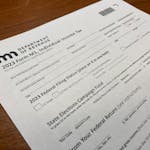Meeting Minnesota's energy efficiency standards will become more challenging and expensive, but utilities can still meet them, a new state study said.
The utilities should be able to cut demand for electricity by 14 percent and natural gas by 11 percent over the next decade, according to the study funded by the Minnesota Department of Commerce. Among the challenges could be the conversion of residential heating units to more energy-efficient systems.
"Minnesota is a longtime national leader in energy efficiency," Bill Grant, head of the energy resources division of the Minnesota Department of Commerce, said in a statement. "This new study outlines how Minnesota can continue its success with both existing and new energy saving measures."
The study released Tuesday looks at the state's energy efficiency potential from 2020 through 2029. The research was led by the Center for Energy and Environment (CEE), a Twin Cities nonprofit group specializing in clean energy and energy efficiency.
Minnesota has had energy efficiency goals for utilities since the early 1980s, bolstering them in 2007 with passage of the Next Generation Energy Act. Since 2011, electric utilities have met or exceeded the state's energy savings goal of 1.5 percent of annual average retail sales, the study said.
The gains have been steady, peaking in 2017, when electric generators — led by investor-owned utilities — hit energy savings of 1.9 percent of average annual sales. Efficiency gains among gas utilities have also grown steadily, hitting a high of 1.5 percent last year.
However, gas utilities have reached the 1.5 percent goal only once since 2011, though they have consistently met the 1 percent minimum prescribed by state law, the study said.
Realistically, investor-owned utilities like Xcel Energy can achieve annual average energy efficiency of 1.9 percent of sales through 2029, while co-op and municipal-owned electricity providers can each hit 1.7 percent, the study concluded. Gas utilities can realistically hit 1.2 percent over the decade.
However, while power producers and other energy stakeholders believe it has been "relatively easy to meet the state goals in recent years," most believe that it will become considerably harder in the next few years, the study concluded.
Meeting those goals also will likely get more expensive, as utilities may have to pay higher incentives and subsidies to customers for adopting energy saving technologies — costs that ultimately get passed to all ratepayers.
Solutions to improving residential heating efficiency are costlier than boosting energy efficiency for lighting. Most lighting efficiency measures — based on today's technology — will be in place by 2021, the study said.
A key to increasing heating efficiency is moving away from electric baseboard heaters to "cold climate air source heat pumps." The latter, which are in a nascent stage, work like an "air conditioner you run in reverse," said Carl Nelson, CEE's director of program development.
Instead of pushing heat out of a building like an air conditioner, an electric heat pump pushes it in. From a physics perspective, there's "heat" in the air even when the temperature is below zero, Nelson said.
The biggest energy savings for natural gas also involve heating, specifically the continued rollout of more energy-efficient gas furnaces, the study said.
Mike Hughlett • 612-673-7003




